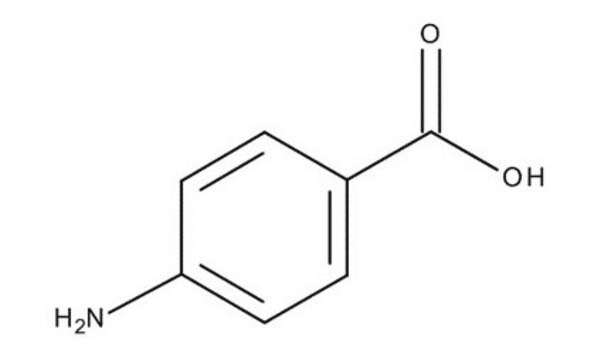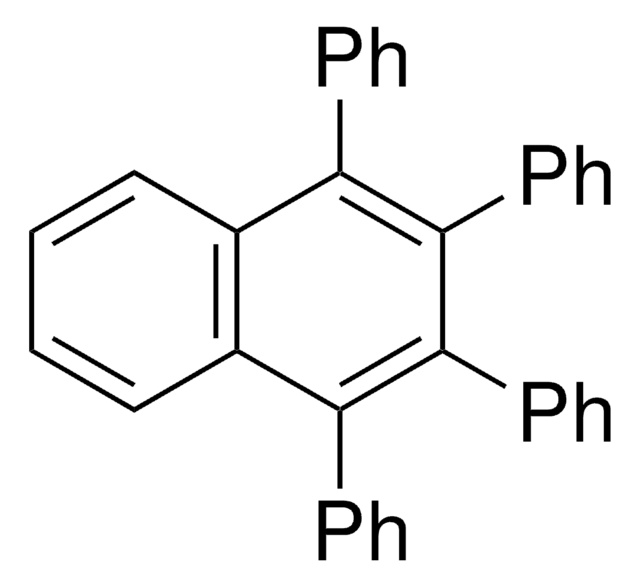8.20112
Anthranilic acid
for synthesis
Synonym(e):
Anthranilic acid, 2-Aminobenzoic acid
About This Item
Empfohlene Produkte
Dampfdruck
0.001 hPa ( 52.6 °C)
Qualitätsniveau
Assay
≥99.0% (acidimetric)
Form
solid
Selbstzündungstemp.
>530 °C
Wirksamkeit
4550 mg/kg LD50, oral (Rat)
mp (Schmelzpunkt)
146-148 °C
Übergangstemp.
flash point 150 °C
Löslichkeit
4.5 g/L
Dichte
1.383 g/cm3 at 23 °C
Schüttdichte
500 kg/m3
Lagertemp.
2-30°C
InChI
1S/C7H7NO2/c8-6-4-2-1-3-5(6)7(9)10/h1-4H,8H2,(H,9,10)
InChIKey
RWZYAGGXGHYGMB-UHFFFAOYSA-N
Verwandte Kategorien
Anwendung
- Anthranilic acid in bio-imaging: Anthranilic acid produced by Virgibacillus salarius MML1918 was characterized for its potential in bio-imaging applications, demonstrating utility in visualizing biological processes (Nandhagopal and Narayanasamy, 2024).
- Anthranilic acid as a metabolite biomarker: A study utilized targeted metabolomics to identify anthranilic acid as a biomarker in Salmonella enteritidis-contaminated chickens, enhancing detection and safety measures in food chemistry (Chen et al., 2023).
- Anthranilic acid in metabolic pathway analysis: A comparative study on the kynurenine pathway in cell lines incorporated anthranilic acid, utilizing LC-MS/MS-based targeted metabolomics to explore selective inhibition of indoleamine and tryptophan 2,3-dioxygenases (Villani et al., 2024).
- Anthranilic acid in quantitative metabolomics: Liquid chromatography-tandem mass spectrometry was used for the simultaneous quantification of tryptophan, serotonin, and kynurenine pathway metabolites, including anthranilic acid, in various biological samples, aiding in comprehensive metabolic profiling (Frobel et al., 2023).
Hinweis zur Analyse
Schmelzbereich (unterer Wert): ≥ 144 °C
Schmelzbereich (oberer Wert): ≤ 147 °C
Identität (IR): entspricht
Signalwort
Danger
H-Sätze
P-Sätze
Gefahreneinstufungen
Eye Dam. 1
Lagerklassenschlüssel
11 - Combustible Solids
WGK
WGK 1
Flammpunkt (°F)
302.0 °F - closed cup
Flammpunkt (°C)
150 °C - closed cup
Analysenzertifikate (COA)
Suchen Sie nach Analysenzertifikate (COA), indem Sie die Lot-/Chargennummer des Produkts eingeben. Lot- und Chargennummern sind auf dem Produktetikett hinter den Wörtern ‘Lot’ oder ‘Batch’ (Lot oder Charge) zu finden.
Besitzen Sie dieses Produkt bereits?
In der Dokumentenbibliothek finden Sie die Dokumentation zu den Produkten, die Sie kürzlich erworben haben.
Kunden haben sich ebenfalls angesehen
Unser Team von Wissenschaftlern verfügt über Erfahrung in allen Forschungsbereichen einschließlich Life Science, Materialwissenschaften, chemischer Synthese, Chromatographie, Analytik und vielen mehr..
Setzen Sie sich mit dem technischen Dienst in Verbindung.











